Allyson Newburg's Blog, page 7
April 2, 2020
An Unsolved Mystery Part 2
Read Unsolved Mystery Part 1
Investigator Binks' belief the airman could be Harris came from a vague physical description, the statement from Vosmer that the airman was a farmer from Winnipeg and his name had a similar ending to ‘Tiss’ or ‘Liss.’ Binks himself conceded the evidence was anything but conclusive.
It is unlikely the airman was Robert Harris for several reasons:
The airman was uninjured. The mystery airman was unhurt when he parachuted from his aircraft. Harris and Smith were in the cockpit of the aircraft when it exploded. It would be hard to imagine Smith being killed and Harris escaping completely uninjured.Harris was never a farmer. Prior to enlisting, Harris worked as a naturalist and had boarded at a farm for a time but was never at any time a farmer. Vosmer spoke to the airman in English though it is clear from his official statements that his familiarity of English was rudimentary.Colbitz and Klein Flöthe are 100 km apart. Klein Flöthe was on the Bomber Command route that evening but Harris’ aircraft was shot down approximately 100 km east in the vicinity of Colbitz, Germany. Harris was the one who gave the ‘Jump’ order and the surviving crew confirmed he was at the front of the plane when it exploded. It is difficult to imagine any circumstance where Harris could parachute to the ground approximately 100 km away from both the crash site and from where the four survivors, Hicks, Kelleher, Nicol and Yemen landed.The pay book. The carrying of identification other than ‘dog tags’ was expressly forbidden and given his regimented personality, Harris would not be carrying any identifying documents.
If not Harris, then who could the mystery airman be?
On the evening of March 7/8, 1945, nineteen Lancasters, a Halifax and a B-24 bomber went down in Germany, resulting in the deaths or unknown whereabouts of 122 Allied airmen. Of those 122, an astounding seven (including Harris) were from the Winnipeg area.
Including airmen killed or declared missing between March 5 and 8, incredibly 21 were from the Winnipeg area and nearly all matched the description of the airman: Brown hair and blue eyes. Unfortunately each of the 21 can be discounted as their remains were positively identified; the wreckage of their aircraft was found too far away; or, because they had no farming experience.
In addition to Wilhelm Bandermann and Gustov Meyer, two other villagers were implicated in the case. Each of the four suspects accused the other in court and with the added complication of Bandermann’s mental health issues (he received a severe head injury in World War I), a conviction for the war crime was never secured.
The Air Ministry Casualty Branch of the RAF closed the case into the identification of the unidentified Canadian airman in 1949. The remains of the mysterious airman of Klein Flöthe are still buried in Hanover Cemetery in Germany.
Investigator Binks' belief the airman could be Harris came from a vague physical description, the statement from Vosmer that the airman was a farmer from Winnipeg and his name had a similar ending to ‘Tiss’ or ‘Liss.’ Binks himself conceded the evidence was anything but conclusive.
It is unlikely the airman was Robert Harris for several reasons:
The airman was uninjured. The mystery airman was unhurt when he parachuted from his aircraft. Harris and Smith were in the cockpit of the aircraft when it exploded. It would be hard to imagine Smith being killed and Harris escaping completely uninjured.Harris was never a farmer. Prior to enlisting, Harris worked as a naturalist and had boarded at a farm for a time but was never at any time a farmer. Vosmer spoke to the airman in English though it is clear from his official statements that his familiarity of English was rudimentary.Colbitz and Klein Flöthe are 100 km apart. Klein Flöthe was on the Bomber Command route that evening but Harris’ aircraft was shot down approximately 100 km east in the vicinity of Colbitz, Germany. Harris was the one who gave the ‘Jump’ order and the surviving crew confirmed he was at the front of the plane when it exploded. It is difficult to imagine any circumstance where Harris could parachute to the ground approximately 100 km away from both the crash site and from where the four survivors, Hicks, Kelleher, Nicol and Yemen landed.The pay book. The carrying of identification other than ‘dog tags’ was expressly forbidden and given his regimented personality, Harris would not be carrying any identifying documents.
If not Harris, then who could the mystery airman be?
On the evening of March 7/8, 1945, nineteen Lancasters, a Halifax and a B-24 bomber went down in Germany, resulting in the deaths or unknown whereabouts of 122 Allied airmen. Of those 122, an astounding seven (including Harris) were from the Winnipeg area.
Including airmen killed or declared missing between March 5 and 8, incredibly 21 were from the Winnipeg area and nearly all matched the description of the airman: Brown hair and blue eyes. Unfortunately each of the 21 can be discounted as their remains were positively identified; the wreckage of their aircraft was found too far away; or, because they had no farming experience.
In addition to Wilhelm Bandermann and Gustov Meyer, two other villagers were implicated in the case. Each of the four suspects accused the other in court and with the added complication of Bandermann’s mental health issues (he received a severe head injury in World War I), a conviction for the war crime was never secured.
The Air Ministry Casualty Branch of the RAF closed the case into the identification of the unidentified Canadian airman in 1949. The remains of the mysterious airman of Klein Flöthe are still buried in Hanover Cemetery in Germany.
Published on April 02, 2020 07:00
April 1, 2020
An Unsolved Mystery Part 1
After the Dessau raid, in the early hours of March 8, 1945, Douglas Hicks, Gordon Nicol, Gerard Kelleher and David Yemen were in custody in the area of Magdeburg, being logged as POWs.
That same morning, a Canadian airman, having baled out from his aircraft, was discovered hiding in a barn in the small German village of Klein Flöthe, located approximately 70 km southeast of Hanover.
Prior to being led away, the airman spoke to the town’s school-teacher, Ernst Vosmer, who had a limited knowledge of English. The brown-haired, blue-eyed airman explained he had parachuted from a disabled aircraft about 5 km away and walked into town. The airman identified himself as an Officer and said that prior to the war, he had been a farmer from outside of Winnipeg.
Vosmer recalled the airman pulled out his pay book to show him his name, but when asked later, the teacher could only remember the pay book had been barely legible and the name had ended in ‘Tiss’ or ‘Liss.’ He later expressed to the RAF investigator, Flight Lieutenant R. B. Binks, that had he known how important this name would be, he would have paid more attention.
Looking out of his schoolhouse window an hour later, Vosmer saw the airman in the company of Wilhelm Bandermann, a widely disliked member of the village and member of the local Volkssturm.
Vosmer described seeing Bandermann carrying a gun, escorting the airman along with another man who was also well known in the village. The trio were walking in the direction of the nearest prisoner-of-war camp 5 km south of town, so Vosmer assumed they were heading there.
Around noon, Vosmer noticed Bandermann returning to the village by himself. That afternoon, when the labourers returned from the fields, word spread through the village that the airman had been shot in the nearby wood. The rumour originated from two labourers, one from Russia, the other from Italy, both of who had been repatriated by the time the investigation had begun. The labourers were said to have seen the unknown airman and a local man enter the woods that morning. Two shots were fired and five minutes after entering, the local man emerged from the wood alone and returned to the village.
On hearing news of these events, the mayor of the neighbouring village of Altenrode and the wife of one of his employees went into the wood to investigate. One kilometre south of Altenrode, they found the dead body of an airman, still dressed in his flying suit, covered in blood and with two bullet holes in his back. Near the body the pair found ashes which appeared to be from burned paper. The airman was buried in Altenrode Cemetery, the grave identified with a white cross marked “Unknown Canadian Airman.”
In a subsequent report two weeks later to the Air Ministry, Investigator Binks asked the reader to recommend whether to continue to register the remains as an unknown Canadian or a suggested identity of Flying Officer Robert Douglas Harris.
Read Unsolved Mystery Part 2
That same morning, a Canadian airman, having baled out from his aircraft, was discovered hiding in a barn in the small German village of Klein Flöthe, located approximately 70 km southeast of Hanover.
Prior to being led away, the airman spoke to the town’s school-teacher, Ernst Vosmer, who had a limited knowledge of English. The brown-haired, blue-eyed airman explained he had parachuted from a disabled aircraft about 5 km away and walked into town. The airman identified himself as an Officer and said that prior to the war, he had been a farmer from outside of Winnipeg.
Vosmer recalled the airman pulled out his pay book to show him his name, but when asked later, the teacher could only remember the pay book had been barely legible and the name had ended in ‘Tiss’ or ‘Liss.’ He later expressed to the RAF investigator, Flight Lieutenant R. B. Binks, that had he known how important this name would be, he would have paid more attention.
Looking out of his schoolhouse window an hour later, Vosmer saw the airman in the company of Wilhelm Bandermann, a widely disliked member of the village and member of the local Volkssturm.
Vosmer described seeing Bandermann carrying a gun, escorting the airman along with another man who was also well known in the village. The trio were walking in the direction of the nearest prisoner-of-war camp 5 km south of town, so Vosmer assumed they were heading there.
Around noon, Vosmer noticed Bandermann returning to the village by himself. That afternoon, when the labourers returned from the fields, word spread through the village that the airman had been shot in the nearby wood. The rumour originated from two labourers, one from Russia, the other from Italy, both of who had been repatriated by the time the investigation had begun. The labourers were said to have seen the unknown airman and a local man enter the woods that morning. Two shots were fired and five minutes after entering, the local man emerged from the wood alone and returned to the village.
On hearing news of these events, the mayor of the neighbouring village of Altenrode and the wife of one of his employees went into the wood to investigate. One kilometre south of Altenrode, they found the dead body of an airman, still dressed in his flying suit, covered in blood and with two bullet holes in his back. Near the body the pair found ashes which appeared to be from burned paper. The airman was buried in Altenrode Cemetery, the grave identified with a white cross marked “Unknown Canadian Airman.”
In a subsequent report two weeks later to the Air Ministry, Investigator Binks asked the reader to recommend whether to continue to register the remains as an unknown Canadian or a suggested identity of Flying Officer Robert Douglas Harris.
Read Unsolved Mystery Part 2
Published on April 01, 2020 07:00
March 31, 2020
March 31, 1945 - Colonel Stark Leaves Camp
With the arrival at Wetzlar of British officers who outranked him, Colonel Stark was no longer the Senior Allied Officer present. Stark drove away from camp, then flew off to France.
Although Colonel Stark appeared to have fled the camp at the earliest opportunity, there was a legitimate reason for him to rush off. While the Americans may have liberated the camp, they were in no hurry to get the prisoners repatriated. With timelines extending to two months being discussed, Stark and two other senior officers were on their way to complain in person to General Elwood Quesada, the U.S. Air Force Lieutenant General at his headquarters in Reims, France.
The same day, the British Commonwealth Air Training Plan officially ended, after graduating over 130,000 pilots, navigators, bombers, wireless operators, gunners and flight engineers belonging to the Royal Air Force, the Royal Canadian Air Force, the Royal Australian Air Force and the Royal New Zealand Air Force.
Although Colonel Stark appeared to have fled the camp at the earliest opportunity, there was a legitimate reason for him to rush off. While the Americans may have liberated the camp, they were in no hurry to get the prisoners repatriated. With timelines extending to two months being discussed, Stark and two other senior officers were on their way to complain in person to General Elwood Quesada, the U.S. Air Force Lieutenant General at his headquarters in Reims, France.
The same day, the British Commonwealth Air Training Plan officially ended, after graduating over 130,000 pilots, navigators, bombers, wireless operators, gunners and flight engineers belonging to the Royal Air Force, the Royal Canadian Air Force, the Royal Australian Air Force and the Royal New Zealand Air Force.
Published on March 31, 2020 07:00
March 30, 2020
Sergeant Edward Hill
Sergeant Edward Hill (Squadron unknown) celebrates the end of five years as a POW when Dulag Luft was liberated . Hill was working at Dulag Luft as an Allied administrator at the camp which explains why he looks so friendly with what was left of the German officers.
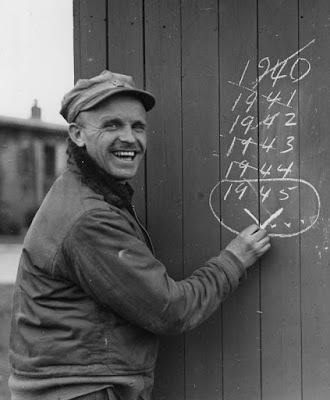 Sergeant Edward Hill
Sergeant Edward Hill
Source: Franklin D. Roosevelt Library
 In this video still, the remaining German officers chat with Allied officers,
In this video still, the remaining German officers chat with Allied officers,
including Sergeant Hill second from right.
 Sergeant Edward Hill
Sergeant Edward HillSource: Franklin D. Roosevelt Library
 In this video still, the remaining German officers chat with Allied officers,
In this video still, the remaining German officers chat with Allied officers,including Sergeant Hill second from right.
Published on March 30, 2020 07:00
March 29, 2020
March 29, 1945 - Hicks and Nicol are Liberated

In this video still, rear air gunner Douglas Hicks (with bandaged forehead) celebrates the liberation of Dulag Luft with his fellow POWs, including long-time prisoner Sergeant Edward Hill at bottom left. The video clip, obtained from CriticalPast.com (labelled Wetzlar, Germany, March 29, 1945 LIB 4857) is one of several discovered by Rolf G. Wilmink, a 75th U.S. Infantry Division history investigator. Three American war correspondents were brought into the camp that day, including noted journalist Jack Belden, though it is unclear who took the original footage. Unfortunately Nicol did not appear in any of the video of the liberation of Dulag Luft.
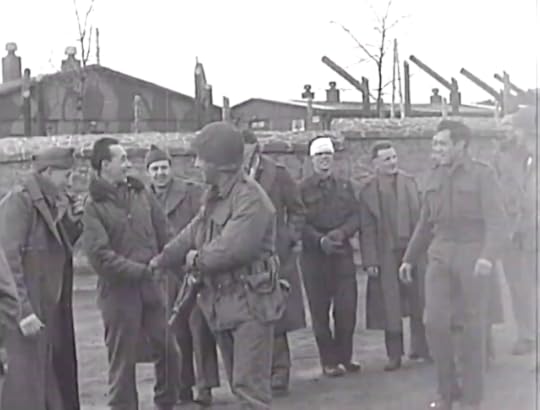
Published on March 29, 2020 07:00
March 28, 2020
Available soon: The Harris Crew!
 Vertical aerial photograph taken over Pforzheim, Germany
Vertical aerial photograph taken over Pforzheim, Germany© Imperial War Museum (C 5083)The story of the Harris Crew is soon to be a book! Finishing touches are in progress but the cover is ready to go!
The background image on the cover has great significance for the crew as it is a shot of the Pforzheim raid the Harris Crew participated in on February 23, 1945.
The silhouette of a Lancaster can be seen in the top left corner. another can be seen below the 'R' in Crew and a third at the bottom under the 'A.'
It isn't hard to imagine why Rear air gunner Douglas Hicks once wrote: "With the aircraft still seemingly out of control the thought passed my mind that perhaps we should bail out. I took one look at the burning inferno beneath me and with no hesitation at all decided that I would rather ride the aircraft into the ground than jump into the burning hell that was Pforzheim."
Published on March 28, 2020 07:00
March 27, 2020
March 27, 1945 - Dulag Luft Evacuations Continue
With the Allied and Russian forces advancing into Germany, camps around the perimeter of the country continued to be evacated being evacuated towards the centre of the country, notably to Stalag Luft XIIID and Stalag Luft VIIA. The first group of POWs to be evacuated from Dulag Luft left on March 20th.
In the early hours of March 27, 1945, a second group consisting of all remaining POWs fit to walk were evacuated from Dulag Luft. It was terrible timing for Kelleher and Yemen, when just two days before Dulag Luft would be liberated, they were marched out of the camp, each with a modest box of Red Cross food stuffs to sustain them along the way. In addition to 169 British and 88 Commonwealth POWs, the group would include the Camp Kommandant and the bulk of the guards.
Hicks and Nicol remained back at Dulag Luft, Hicks, due to his burns, Nicol possibly due to an injured ankle.
143 permanent staff remained at Dulag Luft to continue operations, including Colonel Stark and his staff, German administrative personnel, a few German officers, a doctor and the small number of guards. With the Allies closing in and it being too late to evacuate the remaining POWs, the camp’s Leutnant asked Stark to take charge of the camp.
The Wetzlar camp log for March 27 described heavy fire between German and US forces throughout the day. In the evening, Colonel Stark sent an American flight lieutenant with a German and British sergeant out of the camp to make contact with U.S. forces. Within about an hour, the trio met up with members of the U.S. forces - The American Seventh Armored Division, First Army - and none too soon. It transpired the Americans either had no idea about the camp at Wetzlar, or else did not realize it was still housing prisoners and were to begin shelling the area later that same night.
In the early hours of March 27, 1945, a second group consisting of all remaining POWs fit to walk were evacuated from Dulag Luft. It was terrible timing for Kelleher and Yemen, when just two days before Dulag Luft would be liberated, they were marched out of the camp, each with a modest box of Red Cross food stuffs to sustain them along the way. In addition to 169 British and 88 Commonwealth POWs, the group would include the Camp Kommandant and the bulk of the guards.
Hicks and Nicol remained back at Dulag Luft, Hicks, due to his burns, Nicol possibly due to an injured ankle.
143 permanent staff remained at Dulag Luft to continue operations, including Colonel Stark and his staff, German administrative personnel, a few German officers, a doctor and the small number of guards. With the Allies closing in and it being too late to evacuate the remaining POWs, the camp’s Leutnant asked Stark to take charge of the camp.
The Wetzlar camp log for March 27 described heavy fire between German and US forces throughout the day. In the evening, Colonel Stark sent an American flight lieutenant with a German and British sergeant out of the camp to make contact with U.S. forces. Within about an hour, the trio met up with members of the U.S. forces - The American Seventh Armored Division, First Army - and none too soon. It transpired the Americans either had no idea about the camp at Wetzlar, or else did not realize it was still housing prisoners and were to begin shelling the area later that same night.
Published on March 27, 2020 07:00
March 26, 2020
March 26, 1945 - Purloined Flatware
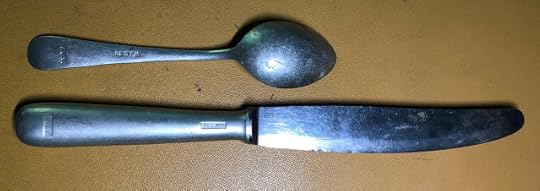
Knife and spoon, imprinted with the Luftwaffe insignia, taken by air bomber Gordon Nicol from Dulag Luft as a memento. The other side of the cutlery is imprinted with FLUV which stands for Flieger unterkunft verwaltung, meaning ‘supplies for Flyer’s quarters.’
Published on March 26, 2020 07:00
March 25, 2020
Flight Logs - Tom Ditson
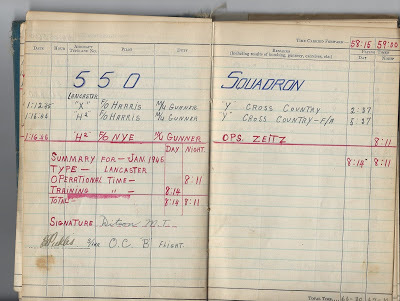
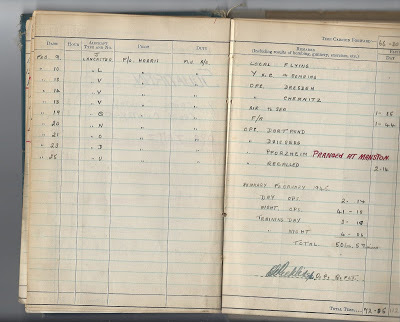
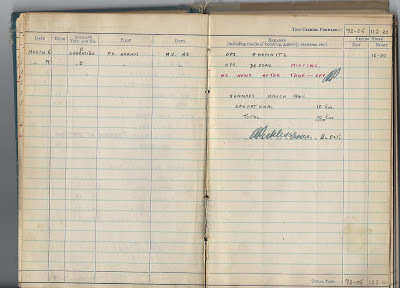
Tom Ditson's flight logs (courtesy of the Ditson family) from 550 Squadron are a bit of a mystery in that several of operations listed, Ditson did not participate in. It is possible the logs were completed by someone else at North Killingholme, who may not have been aware Ditson missed three of the Harris Crew's operations due to illness and two more after being injured during the Pforzheim raid.
Published on March 25, 2020 07:00
March 24, 2020
Eric Raymond Robinson
Eric Raymond Robinson served with the Harris Crew as the mid-upper air gunner on three operations: Dortmund on February 20, 1945, Chemnitz on March 5, 1945 and the crew's final operation to Dessau on March 7, 1945.
After the crash, Robinson remains were buried by the Germans in Colbitz Cemetery. On September 16, 1948, his remains were disinterred and reburied the following day in the British Cemetery, Berlin in Plot 2, Row L, #20, next to crewmate Kenneth Smith. The engraving reads “His life a beautiful memory, His absence a silent grief.”
Robinson is also memorialized at The International Bomber Command Centre in Lincoln, UK, phase 1, panel 91. Unfortunately no photos of Robinson are available.
After the crash, Robinson remains were buried by the Germans in Colbitz Cemetery. On September 16, 1948, his remains were disinterred and reburied the following day in the British Cemetery, Berlin in Plot 2, Row L, #20, next to crewmate Kenneth Smith. The engraving reads “His life a beautiful memory, His absence a silent grief.”
Robinson is also memorialized at The International Bomber Command Centre in Lincoln, UK, phase 1, panel 91. Unfortunately no photos of Robinson are available.
Published on March 24, 2020 07:00



